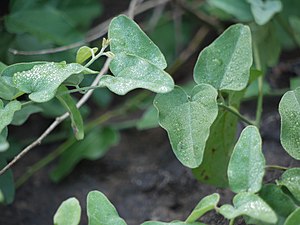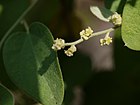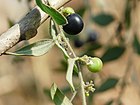Note: This is a project under development. The articles on this wiki are just being initiated and broadly incomplete. You can Help creating new pages.
Difference between revisions of "Cocculus hirsutus - Patalagarudi"
(→References) |
(→References) |
||
| Line 80: | Line 80: | ||
<references> | <references> | ||
| − | <ref name="Uses">https://easyayurveda.com/2015/03/10/patala-garudi-cocculus-hirsutus-uses-dose-research/ "Uses"]</ref> | + | <ref name="Uses">[https://easyayurveda.com/2015/03/10/patala-garudi-cocculus-hirsutus-uses-dose-research/ "Uses"]</ref> |
<ref name="Chemical composition">[http://gbpihedenvis.nic.in/PDFs/Glossary_Medicinal_Plants_Springer.pdf "Chemical composition"]</ref> | <ref name="Chemical composition">[http://gbpihedenvis.nic.in/PDFs/Glossary_Medicinal_Plants_Springer.pdf "Chemical composition"]</ref> | ||
Revision as of 11:42, 25 June 2019
Patalagarudiis a slender climber with soft hairy leaves. This plant can be found in dry areas during and after the monsoon.
Contents
- 1 Uses
- 2 Parts Used
- 3 Chemical Composition
- 4 Common names
- 5 Properties
- 6 Habit
- 7 Identification
- 8 List of Ayurvedic medicine in which the herb is used
- 9 Where to get the saplings
- 10 Mode of Propagation
- 11 How to plant/cultivate
- 12 Commonly seen growing in areas
- 13 Photo Gallery
- 14 References
- 15 External Links
Uses
Aphrodisiac, Burning sensation, Gastritis, Skin diseases, Poisoning [1]
Parts Used
Bark, Leaves, Heartwood, Seeds
Chemical Composition
The stem contains cyclopeptide alkaloids. The plant contains coclaurine, magnoflorine, beta-sitosterol, ginnol and a monomethyl ether of inositol. [2]
Common names
| Language | Common name |
|---|---|
| Kannada | aadama balli, adambuballi, daagadiballi, kaage maari, sugadi balli |
| Hindi | bajar bel, jamti-ki-bel, patal garudi |
| Malayalam | Pathalagarudakkodi |
| Tamil | anantavalli, calakattu, kattukkodi, nirppantikkoti, uppaittiricci |
| Telugu | cheepurutheega, chipurutige, doosaratheege |
| Marathi | NA |
| Gujarathi | NA |
| Punjabi | NA |
| Kashmiri | NA |
| Sanskrit | Garudi, chilahinta, Vatsadani, vikranta |
| English |
Properties
Reference: Dravya - Substance, Rasa - Taste, Guna - Qualities, Veerya - Potency, Vipaka - Post-digesion effect, Karma - Pharmacological activity, Prabhava - Therepeutics.
Dravya
Rasa
Tikta (Bitter)
Guna
Laghu (Light), Picchila (Sticky)
Veerya
Ushna (Hot)
Vipaka
Katu (Pungent)
Karma
Vata, Pitta,Kapha
Prabhava
Vishagna (Anti-poison)
Habit
Identification
Leaf
| Kind | Shape | Feature |
|---|---|---|
| Simple | alternate | 1.5-7 x 0.5-4.7 cm, variable in shape, the lower leaves of the main branches larger, sometimes 3-5 lobed, upper leaves smaller, narrowly to broadly ovate to elliptic, base cuneate to slightly cordate, apex obtuse to rounded and mucronulate, basal nerves 5; petioles 0.3-2 cm, long, pilose. Inflorescence of 2-3 cymules clustered together, peduncled, 0.5-2.5 cm long, tomentose. |
Flower
| Type | Size | Color and composition | Stamen | More information |
|---|---|---|---|---|
| Unisexual | axillary | Greenish yellow | Male flowers: sepals greenish, pilose, 3 inner broadly ovate to obovate, 1.5-2.5 mm long, 3 outer oblong to lanceolate, 1.4-2 mm long; petals ovate-oblong, 0.5-1.5 mm long, sparsely pubescent to glabrous; stamens 0.7-1 mm long. Female flowers: staminodes 0.5 mm long; carpels 3, 0.7-1 mm long. |
Fruit
| Type | Size | Mass | Appearance | Seeds | More information |
|---|---|---|---|---|---|
| A drupe | 4 - 8mm | turning black, 4-8 mm diam.; endocarp ridged with a prominent do | {{{5}}} | {{{6}}} |
Other features
List of Ayurvedic medicine in which the herb is used
Where to get the saplings
Mode of Propagation
How to plant/cultivate
Season to grow
Soil type
Propagation
Commonly seen growing in areas
Photo Gallery
References
External Links
- Ayurvedic Herbs known to be helpful to treat Aphrodisiac
- Ayurvedic Herbs known to be helpful to treat Burning sensation
- Ayurvedic Herbs known to be helpful to treat Gastritis
- Ayurvedic Herbs known to be helpful to treat Skin diseases
- Ayurvedic Herbs known to be helpful to treat Poisoning
- Herbs with Bark used in medicine
- Herbs with Leaves used in medicine
- Herbs with Heartwood used in medicine
- Herbs with Seeds used in medicine
- Herbs with common name in Kannada
- Herbs with common name in Hindi
- Herbs with common name in Malayalam
- Herbs with common name in Tamil
- Herbs with common name in Telugu
- Herbs with common name in Sanskrit
- Habit - Climber
- Index of Plants which can be propagated by Seeds
- Index of Plants which can be propagated by Cuttings
- Herbs that are commonly seen in the region of Tropical area
- Herbs
- Climber
- Ayurvedic herbs that don't have seed photos
- Menispermaceae




